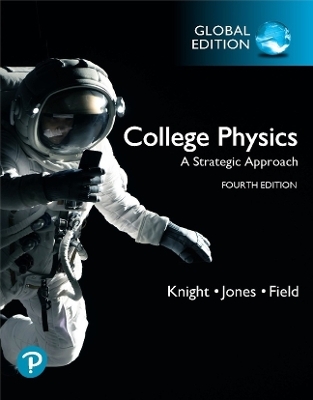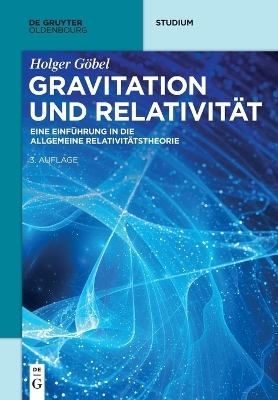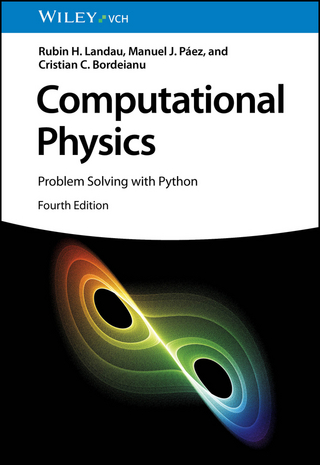
College Physics: A Strategic Approach, Global Edition
Pearson (Verlag)
978-1-292-27776-9 (ISBN)
- Titel nicht im Sortiment
- Artikel merken
Make physics relevant for today's mixed-majors students
College Physics: A Strategic Approach, 4th Edition expands its focus from how mixed majors students learn physics to focusing on why these students learn physics. The authors apply the best results from educational research and MasteringTM Physics metadata to present basic physics in real world examples that engage students and connect physics with other fields, including biological sciences, architecture, and natural resources. From these connections, students not only learn in research-driven ways but also understand why they are taking the course and how it applies to other areas.
Extensive new media and an interactive Pearson eText pique student interest while challenging misconceptions and fostering critical thinking. New examples, explanations, and problems use real data from research to show physics at work in relatable situations, and help students see that physics is the science underlying everything around them. A Strategic Approach, 4th Edition, encourages today's students to understand the big picture, gain crucial problem-solving skills and come to class both prepared and confident.
Also available with Mastering Physics
MasteringTM is the teaching and learning platform that empowers you to reach every student. By combining trusted author content with digital tools developed to engage students and emulate the office-hour experience, Mastering personalizes learning and often improves results for each student. With Learning CatalyticsTM instructors can expand on key concepts and encourage student engagement during lecture through questions answered individually or in pairs and groups. Students also master concepts through book-specific Mastering Physics assignments, which provide hints and answer-specific feedback that build problem-solving skills. Mastering Physics now provides students with the new Physics Primer for remediation of math skills needed in the college physics course.
Full Version, All Chapters: Chs 1-30
Volume 1: Chs 1-16
Volume 2: Chs 17-30
PART I FORCE AND MOTION
OVERVIEW The Science of Physics
Representing Motion
1.1 Motion: A First Look
1.2 Models and Modeling
1.3 Position and Time: Putting Numbers on Nature
1.4 Velocity
1.5 A Sense of Scale: Significant Figures, Scientific Notation, and Units
1.6 Vectors and Motion: A First Look
1.7 Where Do We Go from Here?
SUMMARY
QUESTIONS AND PROBLEMS
Motion in One Dimension
2.1 Describing Motion
2.2 Uniform Motion
2.3 Instantaneous Velocity
2.4 Acceleration
2.5 Motion with Constant Acceleration
2.6 Solving One-Dimensional Motion Problems
2.7 Free Fall
SUMMARY
QUESTIONS AND PROBLEMS
Vectors and Motion in Two Dimensions
3.1 Using Vectors
3.2 Coordinate Systems and Vector Components
3.3 Motion on a Ramp
3.4 Motion in Two Dimensions
3.5 Projectile Motion
3.6 Projectile Motion: Solving Problems
3.7 Circular Motion
3.8 Relative Motion
SUMMARY
QUESTIONS AND PROBLEMS
Forces and Newton's Laws of Motion
4.1 Motion and Forces
4.2 A Short Catalog of Forces
4.3 Identifying Forces
4.4 What Do Forces Do?
4.5 Newton's Second Law
4.6 Free-Body Diagrams
4.7 Newton's Third Law
SUMMARY
QUESTIONS AND PROBLEMS
Applying Newton's Laws
5.1 Equilibrium
5.2 Dynamics and Newton's Second Law
5.3 Mass and Weight
5.4 Normal Forces
5.5 Friction
5.6 Drag
5.7 Interacting Objects
5.8 Ropes and Pulleys
SUMMARY
QUESTIONS AND PROBLEMS
Circular Motion, Orbits, and Gravity
6.1 Uniform Circular Motion
6.2 Dynamics of Uniform Circular Motion
6.3 Apparent Forces in Circular Motion
6.4 Circular Orbits and Weightlessness
6.5 Newton's Law of Gravity
6.6 Gravity and Orbits
SUMMARY
QUESTIONS AND PROBLEMS
Rotational Motion
7.1 Describing Circular and Rotational Motion
7.2 The Rotation of a Rigid Body
7.3 Torque
7.4 Gravitational Torque and the Center of Gravity
7.5 Rotational Dynamics and Moment of Inertia
7.6 Using Newton's Second Law for Rotation
7.7 Rolling Motion
SUMMARY
QUESTIONS AND PROBLEMS
Equilibrium and Elasticity
8.1 Torque and Static Equilibrium
8.2 Stability and Balance
8.3 Springs and Hooke's Law
8.4 Stretching and Compressing Materials
8.5 Forces and Torques in the Body
SUMMARY
QUESTIONS AND PROBLEMS
PART I SUMMARY Force and Motion
ONE STEP BEYOND Dark Matter and the Structure of the Universe
PART I PROBLEMS
PART II CONSERVATION LAWS
OVERVIEW Why Some Things Stay the Same
Momentum
9.1 Impulse
9.2 Momentum and the Impulse-Momentum Theorem
9.3 Solving Impulse and Momentum Problems
9.4 Conservation of Momentum
9.5 Inelastic Collisions
9.6 Momentum and Collisions in Two Dimensions
9.7 Angular Momentum
SUMMARY
QUESTIONS AND PROBLEMS
Energy and Work
10.1 The Basic Energy Model
10.2 Work
10.3 Kinetic Energy
10.4 Potential Energy
10.5 Thermal Energy
10.6 Conservation of Energy
10.7 Energy Diagrams
10.8 Molecular Bonds and Chemical Energy
10.9 Energy in Collisions
10.10 Power
SUMMARY
QUESTIONS AND PROBLEMS
Using Energy
11.1 Transforming Energy
11.2 Energy in the Body
11.3 Temperature, Thermal Energy, and Heat
11.4 The First Law of Thermodynamics
11.5 Heat Engines
11.6 Heat Pumps
11.7 Entropy and the Second Law of Thermodynamics
11.8 Systems, Energy, and Entropy
SUMMARY
QUESTIONS AND PROBLEMS
PART II SUMMARY Conservation Laws
ONE STEP BEYOND Order Out of Chaos
PART II PROBLEMS
PART III PROPERTIES OF MATTER
OVERVIEW Beyond the Particle Model
Thermal Properties of Matter
12.1 The Atomic Model of Matter
12.2 The Atomic Model of an Ideal Gas
12.3 Ideal-Gas Processes
12.4 Thermal Expansion
12.5 Specific Heat and Heat of Transformation
12.6 Calorimetry
12.7 Specific Heats of Gases
12.8 Heat Transfer
12.9 Diffusion
SUMMARY
QUESTIONS AND PROBLEMS
Fluids
13.1 Fluids and Density
13.2 Pressure
13.3 Buoyancy
13.4 Fluids in Motion
13.5 Fluid Dynamics
13.6 Viscosity and Poiseuille's Equation
13.7 The Circulatory System
SUMMARY
QUESTIONS AND PROBLEMS
PART III SUMMARY Properties of Matter
ONE STEP BEYOND Size and Life
PART III PROBLEMS
PART IV OSCILLATIONS AND WAVES
OVERVIEW Motion That Repeats Again and Again
Oscillations
14.1 Equilibrium and Oscillation
14.2 Linear Restoring Forces and SHM
14.3 Describing Simple Harmonic Motion
14.4 Energy in Simple Harmonic Motion
14.5 Pendulum Motion
14.6 Damped Oscillations
14.7 Driven Oscillations and Resonance
SUMMARY
QUESTIONS AND PROBLEMS
Traveling Waves and Sound
15.1 The Wave Model
15.2 Traveling Waves
15.3 Graphical and Mathematical Descriptions of Waves
15.4 Sound and Light Waves
15.5 Energy and Intensity
15.6 Loudness of Sound
15.7 The Doppler Effect and Shock Waves
SUMMARY
QUESTIONS AND PROBLEMS
Superposition and Standing Waves
16.1 The Principle of Superposition
16.2 Standing Waves
16.3 Standing Waves on a String
16.4 Standing Sound Waves
16.5 Speech and Hearing
16.6 The Interference of Waves from Two Sources
16.7 Beats
SUMMARY
QUESTIONS AND PROBLEMS
PART IV SUMMARY Oscillations and Waves
ONE STEP BEYOND Waves in the Earth and the Ocean
PART IV PROBLEMS
PART V OPTICS
OVERVIEW Light Is a Wave
Wave Optics
17.1 What Is Light?
17.2 The Interference of Light
17.3 The Diffraction Grating
17.4 Thin-Film Interference
17.5 Single-Slit Diffraction
17.6 Circular-Aperture Diffraction
SUMMARY
QUESTIONS AND PROBLEMS
Ray Optics
18.1 The Ray Model of Light
18.2 Reflection
18.3 Refraction
18.4 Image Formation by Refraction
18.5 Thin Lenses: Ray Tracing
18.6 Image Formation with Spherical Mirrors
18.7 The Thin-Lens Equation
SUMMARY
QUESTIONS AND PROBLEMS
Optical Instruments
19.1 The Camera
19.2 The Human Eye
19.3 The Magnifier
19.4 The Microscope
19.5 The Telescope
19.6 Color and Dispersion
19.7 Resolution of Optical Instruments
SUMMARY
QUESTIONS AND PROBLEMS
PART V SUMMARY Optics
ONE STEP BEYOND Scanning Confocal Microscopy
PART V PROBLEMS
PART VI ELECTRICITY AND MAGNETISM
OVERVIEW Charges, Currents, and Fields
Electric Fields and Forces
20.1 Charges and Forces
20.2 Charges, Atoms, and Molecules
20.3 Coulomb's Law
20.4 The Concept of the Electric Field
20.5 The Electric Field from Arrangements of Charges
20.6 Conductors and Electric Fields
20.7 Forces and Torques in Electric Fields
SUMMARY
QUESTIONS AND PROBLEMS
Electric Potential
21.1 Electric Potential Energy and Electric Potential
21.2 Sources of Electric Potential
21.3 Electric Potential and Conservation of Energy
21.4 Calculating the Electric Potential
21.5 Connecting Potential and Field
21.6 The Electrocardiogram
21.7 Capacitance and Capacitors
21.8 Energy and Capacitors
SUMMARY
QUESTIONS AND PROBLEMS
Current and Resistance
22.1 A Model of Current
22.2 Defining and Describing Current
22.3 Batteries and emf
22.4 Connecting Potential and Current
22.5 Ohm's Law and Resistor Circuits
22.6 Energy and Power
SUMMARY
QUESTIONS AND PROBLEMS
Circuits
23.1 Circuit Elements and Diagrams
23.2 Kirchhoff's Laws
23.3 Series and Parallel Circuits
23.4 Measuring Voltage and Current
23.5 More Complex Circuits
23.6 Capacitors in Parallel and Series
23.7 RC Circuits
23.8 Electricity in the Nervous System
SUMMARY
QUESTIONS AND PROBLEMS
Magnetic Fields and Forces
24.1 Magnetism
24.2 The Magnetic Field
24.3 Electric Currents Also Create Magnetic Fields
24.4 Calculating the Magnetic Field Due to a Current
24.5 Magnetic Fields Exert Forces on Moving Charges
24.6 Magnetic Fields Exert Forces on Currents
24.7 Magnetic Fields Exert Torques on Dipoles
24.8 Magnets and Magnetic Materials
SUMMARY
QUESTIONS AND PROBLEMS
EM Induction and EM Waves
25.1 Induced Currents
25.2 Motional emf
25.3 Magnetic Flux and Lenz's Law
25.4 Faraday's Law
25.5 Electromagnetic Waves
25.6 The Photon Model of Electromagnetic Waves
25.7 The Electromagnetic Spectrum
SUMMARY
QUESTIONS AND PROBLEMS
AC Electricity
26.1 Alternating Current
26.2 AC Electricity and Transformers
26.3 Household Electricity
26.4 Biological Effects and Electrical Safety
26.5 Capacitor Circuits
26.6 Inductors and Inductor Circuits
26.7 Oscillation Circuits
SUMMARY
QUESTIONS AND PROBLEMS
PART VI SUMMARY Electricity and Magnetism
ONE STEP BEYOND The Greenhouse Effect and Global Warming
PART VI PROBLEMS
PART VII MODERN PHYSICS
OVERVIEW New Ways of Looking at the World
Relativity
27.1 Relativity: What's It All About?
27.2 Galilean Relativity
27.3 Einstein's Principle of Relativity
27.4 Events and Measurements
27.5 The Relativity of Simultaneity
27.6 Time Dilation
27.7 Length Contraction
27.8 Velocities of Objects in Special Relativity
27.9 Relativistic Momentum
27.10 Relativistic Energy
SUMMARY
QUESTIONS AND PROBLEMS
Quantum Physics
28.1 X Rays and X-Ray Diffraction
28.2 The Photoelectric Effect
28.3 Photons
28.4 Matter Waves
28.5 Energy Is Quantized
28.6 Energy Levels and Quantum Jumps
28.7 The Uncertainty Principle
28.8 Applications and Implications of Quantum Theory
SUMMARY
QUESTIONS AND PROBLEMS
Atoms and Molecules
29.1 Spectroscopy
29.2 Atoms
29.3 Bohr's Model of Atomic Quantization
29.4 The Bohr Hydrogen Atom
29.5 The Quantum-Mechanical Hydrogen Atom
29.6 Multi-electron Atoms
29.7 Excited States and Spectra
29.8 Molecules
29.9 Stimulated Emission and Lasers
SUMMARY
QUESTIONS AND PROBLEMS
Nuclear Physics
30.1 Nuclear Structure
30.2 Nuclear Stability
30.3 Forces and Energy in the Nucleus
30.4 Radiation and Radioactivity
30.5 Nuclear Decay and Half-Lives
30.6 Medical Applications of Nuclear Physics
30.7 The Ultimate Building Blocks of Matter
SUMMARY
QUESTIONS AND PROBLEMS
PART VII SUMMARY MODERN PHYSICS
ONE STEP BEYOND The Physics of Very Cold Atoms
PART VII PROBLEMS
APPENDICES
Mathematics Review
Periodic Table of Elements
Atomic and Nuclear Data
Answers to Odd-Numbered Problems
| Erscheinungsdatum | 26.07.2023 |
|---|---|
| Sprache | englisch |
| Maße | 215 x 277 mm |
| Gewicht | 2460 g |
| Themenwelt | Naturwissenschaften ► Physik / Astronomie |
| ISBN-10 | 1-292-27776-9 / 1292277769 |
| ISBN-13 | 978-1-292-27776-9 / 9781292277769 |
| Zustand | Neuware |
| Informationen gemäß Produktsicherheitsverordnung (GPSR) | |
| Haben Sie eine Frage zum Produkt? |
aus dem Bereich


